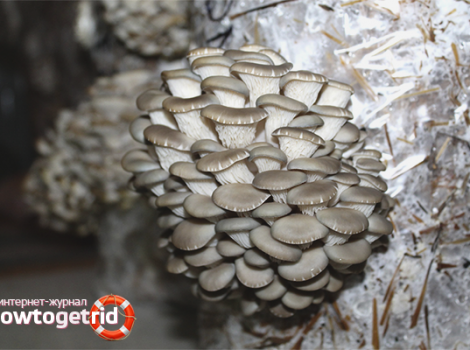Content [show]
Often, the owners of summer cottages pay very little attention to the cultivation of asparagus. In some flower beds, a green "herringbone" decorates the flower bed, does not require special care, its branches are added to bouquets - that's all the use of a useful plant. And if you plant the bushes correctly and organize good care for them, you can indulge yourself with a vegetable delicacy, which in many countries can only be afforded by people with high incomes. Your main task is to choose the right place for asparagus in your dacha - this is how asparagus is called in another way - and it will give a tasty harvest for more than a dozen years.

Preparation of planting material
The easiest way to get planting material is to buy a root in a specialized center. There they will explain to you the features of each variety, tell you what kind of soil and care it needs.
Popular among gardeners are asparagus of the following varieties:
- Early Yellow - prized for its yield and disease resistance;
- "Arzhentelskaya" - has excellent taste;
- "Tsarskaya" - received recognition from gardeners for its resistance to frost and drought;
- "Gainlim" - gives a lot of shoots.
You can get the material yourself from an adult bush. The first way: divide the rhizome into parts, take several fragments for growing and plant them in the country. The second option: cut the cuttings from one-year-old shoots, dip the lower parts in a growth stimulator and stick them in the sand. Seedlings need to create suitable rooting conditions and provide proper care at home. Cover them with the necks of plastic bottles, on hot days, remove the caps and moisten the soil in a timely manner. When the plants are well established, transplant them to a permanent location.
Growing from seeds is a very laborious task; you cannot plant them immediately on the garden bed. The grains should be soaked in water and kept in a warm place at + 30⁰ for 2 days. When the seeds swell, you need to grow strong seedlings and only then plant them in open ground. Most often, the grains are planted in a greenhouse, for this you need to carefully prepare the place. Make furrows, put black soil on the bottom, to which superphosphate and ash are added. The top layer is garden soil with fallen leaves and manure. The planting depth should be about 2-4 cm, the distance between plants should be at least 3 cm.
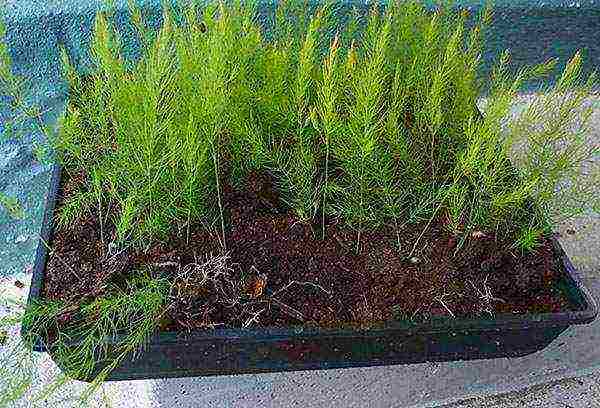
Growing asparagus at home
Those who do not have a summer residence sometimes wonder if it is possible to grow edible shoots from seeds on a balcony or on a windowsill. At home, you can only grow seedlings or asparagus indoor flower. To get the first harvest, the plant must be 3 years old. During this time, a very long root will develop. Of course, you can put a large tub in the room and plant 1 bush, but the harvest will be so insignificant that there is no point in doing such work.
Advice
If you are looking to buy a delicacy from the store, remember that asparagus and soy asparagus have nothing to do with asparagus. The first of them is also a very tasty and healthy plant of the legume family. The second name is a semi-finished product made from soybeans.
If you want to grow seedlings from seeds, plant the seeds in separate deep cups. Fill them with a mixture of equal parts garden soil, peat, sand and rotted manure. Seedlings require careful care. The plant does not tolerate dryness, moisten the soil daily. 2 weeks after germination, feed with complex fertilizer.
When the seedlings grow to 15 cm, start hardening the seedlings. Take it out to fresh air or ventilate the greenhouse first for 1-2 hours in the warmest time. Gradually increase your time outdoors. When the seedlings can stand in the air constantly without any changes for the worse, you can plant them in open ground in the country.
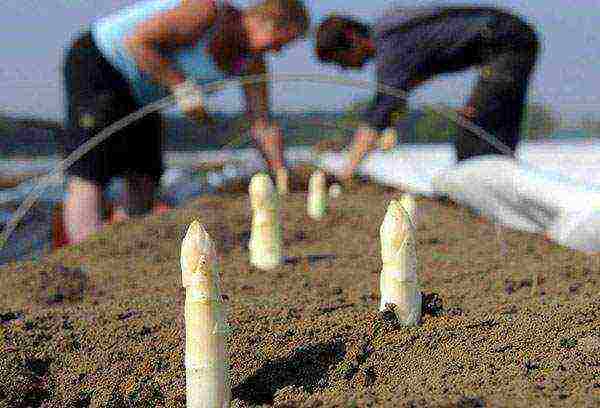
Site preparation
It is not for nothing that asparagus is very expensive. It takes up a lot of space, it takes a lot of time from sowing seeds to harvest, and the number of shoots is small. For those who are trying to collect a large amount of vegetables from a small garden, it is better to abandon this culture. And yet, find a small area in the garden where you can plant at least 3-4 bushes, and grow several seedlings at home. When you taste the juicy shoots after 3 years, your attitude towards asparagus will change.
At the dacha, you need to start preparing asparagus soil in the fall. Note that each bush will need 0.25 m2 of empty space. The site must be sunny, sheltered from the wind. The plant does not tolerate stagnant moisture; with a high occurrence of groundwater, good drainage or bulk beds are definitely needed. Most of all, asparagus likes fertile sandy loam. When digging in autumn, add per 1 m2:
- Compost - 20 kg;
- Superphosphate - 70 g;
- Potassium sulfate - 40 g.
If you dug the garden well in the fall, you can only loosen it in the spring. When harrowing, 60 g of ash and 20 g of ammonium nitrate are introduced per 1 m2. The wells should be spacious, 35 cm in diameter and depth. In June, you can plant home-grown bushes in a permanent place. In the hole, make a mound of fertile soil, shorten the root of the seedling to 4 cm and set the plant on the embankment. Bury a hole, compact and water the soil well. In the future, young bushes will need proper care, then they will grow thick and strong.
After planting, mulch the bed with sawdust or leaf compost. This procedure will keep the soil loose, prevent weeds from breaking through, and keep the roots from freezing during the winter months. In the early years, while the bushes are still small, use the space between them for growing from spice seeds and herbs.
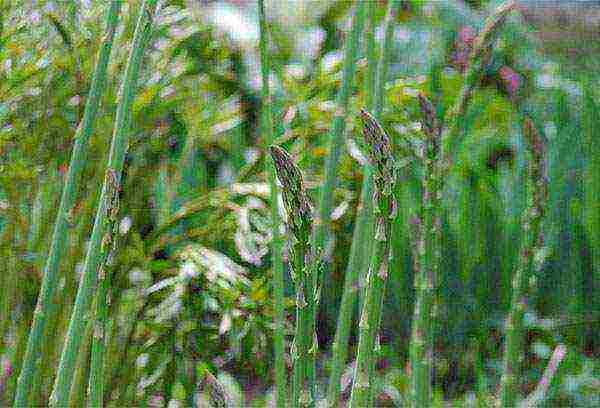
Proper care - a good harvest
Asparagus is a fairly large bush that has been growing in one place for many years. For proper development, it needs a lot of nutrients, and the soil is depleted over time. If you want to get good yields up to 25 years, fertilize the area with manure every fall, and apply compost in the spring. In order for the shoots to grow faster and the harvest becomes richer, do not spare organic matter, water the beds with slurry every 3 weeks.
Do not allow the soil to dry out; on dry days, water the garden bed in the country every day, especially during the growing season of edible shoots. If the sprouts don't get enough moisture, they will become bitter and tough. Excessive humidity or stagnant air is also dangerous: plants can be infected with a fungal infection. After each watering, it is necessary to loosen the top layer well. If you want to make it easier to care for the plants, mulch the bed with peat or compost when planting. With a layer thickness of more than 5 cm, not a single weed will appear on the garden bed.
You can see that if you plant asparagus in an open area with strong winds, it grows poorly, often gets sick. This does not happen from the cold, but from the fact that the roots of the plant are sensitive to any movement of the aboveground part. A strong flow of air shakes the stems, while small underground root processes break off, and the entire system begins to rot.To prevent this from happening in your garden, be sure to install a strong stake and tie shoots to it. To prevent scattered seeds from germinating and not making it difficult to care for the garden, remove the fruits that have appeared on the branches.
Advice
If you want to harvest asparagus grains, do not cut the shoots, let the bush develop. Please note that both male and female specimens must grow on the site to obtain viable seeds.
The asparagus rhizome grows upward every year and gradually emerges from the soil. Inspect the plantings several times a season and huddle them. This will enable the normal development of the underground part of the plant. At the end of summer, cut off the yellowed shoots, and before the onset of cold weather, cut off all the stems and cover the ground with peat or sawdust at least 5 cm thick.Rhizomes of adult plants will not die even in severe frosts, and spring frosts are dangerous for young shoots.

Diseases and pests of green bushes
Asparagus rarely gets sick, but sometimes it can get infected with fungal infections. Basically, such problems arise if the care of the plant is done incorrectly. The cause of diseases is excessive moisture in the soil or air. Bushes do not like strong winds, but they need fresh air. Do not arrange a bed in a completely enclosed space, allow a light breeze to penetrate there. For prevention, you can spray plantings with fungicides in the spring and autumn.
Among insects, asparagus has 2 enemies.
- Asparagus fly. Brown midge with yellow legs and head. Its appearance can be determined by twisted and withering shoots.
- Asparagus leaf beetle. A beetle with blue wings and a red stripe. Eats up all parts of the plant. It is especially active in the second half of summer.
Spray plants with insecticides to combat parasites. When watering, pay attention to emerging pest eggs. Cut off damaged branches and burn them. To prevent insects from settling on plants, remove dry and damaged shoots in time, fight weeds. Proper care will save you the trouble of growing asparagus.
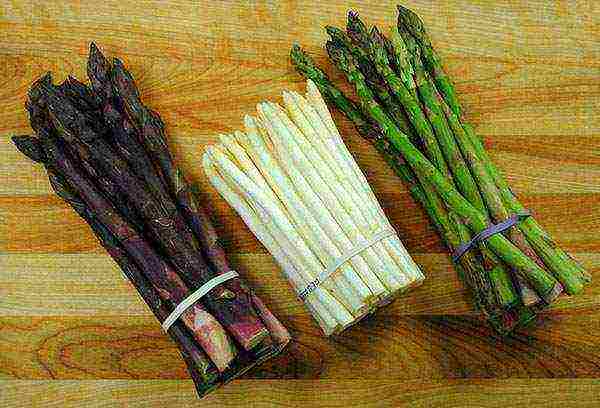
How to properly harvest and preserve the crop
The gardener is eager to taste the young sprouts. Take your time: until the plant is 3 years old, you cannot cut off the shoots. Wait until the bush has accumulated enough strength, then in the next years it will give you good harvests. The first time, cut no more than 5 stems, leave the rest for the development of a strong bush. From good adult specimens, the gardener can collect up to 30 sprouts per season. Never remove all shoots: if not a single branch remains, the bush may die.
Shoots that have reached 20 cm in height, on which leaf buds have not yet bloomed, are suitable for food. As soon as the first needles begin to form, the stems will become tough and unsuitable for food. Break open the soil and break off with your hands or cut off the shoots with a knife near the rhizome, just proceed carefully so as not to disturb or injure the root system. You can harvest all summer, but the richest spring months.
There are 3 product categories.
- White asparagus is the most valuable species. These shoots were dug out of the ground, were not exposed to sunlight and retained the maximum concentration of nutrients.
- Purple asparagus was not exposed to light for long and did not have time to develop chlorophyll. It tastes slightly bitter.
- Green asparagus grew in the sun, accumulated a lot of chlorophyll and carbohydrates, but lost some of the vitamins. Bitter taste.
Everyone's preferences are different, some gourmets consider white asparagus the most delicious and tender, others argue that green shoots have a richer and richer taste. If you want to taste the white sprouts, protect them from light. In the fall, after cutting the stems, make an earthen mound about 20 cm high above the roots. In the spring, keep an eye on the soil surface. When you notice bumps or small cracks, gently break up the soil to the root.Cut off the shoots that have reached the desired height and restore the embankment again. After a few days, the next shoots will begin to break through to the surface, dig up the ground again and harvest.
Advice
If in the fall you did not make mounds, in the spring you can cover the ground with boxes or make a shelter from a material that does not transmit light: black film, roofing material.
Fresh shoots should be eaten immediately or used for cooking, preparations for the winter. If you need to use the asparagus later, place it in a jar of water like a bouquet and put it in the refrigerator. Remember that if there are products with a strong smell on the shelves, the shoots will absorb the extraneous odors. Sprouts can be frozen, but at the same time they will lose some of their taste and useful qualities.

Conclusion
Don't believe the rumor that asparagus is a very capricious plant, that growing asparagus from seed outdoors and caring for it is too time-consuming. The most difficult thing happens in the first year, when growing seedlings at home or in a greenhouse, and when the bushes take root and begin to develop well, they do not require much attention from you. It is necessary to cultivate the soil well once and plant asparagus correctly in the country, and then it will grow in one place for many years.
In order for the shoots to turn out white and delicate in taste, they must be protected from light. The most convenient way is to pour a mound of earth over the plant in the fall, after cutting the stems, and dig out the soil during harvesting. When cutting, do not be greedy, do not completely remove all the stems, leave something for the development of the bush. The faster you put the product into processing, the tastier and healthier the dish will turn out. Use asparagus for salads, soups, vegetable side dishes, and feel like a millionaire who has access to expensive delicacies.
The business in the field of growing vegetables and fruits has been and remains profitable at any time of the year. In a previous post, we looked at the idea of growing dill and parsley as a business, in today's article, let's talk about asparagus and how to make money from it.
Korean food lovers have probably tried a dish like asparagus. This delicacy can be purchased at any major supermarket. Asparagus are long, porous chunks of beige color and are usually sold pickled. Many lovers of this dish mistakenly believe that this ready-made Korean dish is asparagus and is made from a plant. In fact, this Korean delicacy has nothing to do with asparagus.
Famous Korean salads are made from fuju - a film of soy milk. And real asparagus (asparagus) is a short plant that lives in areas with a warm and dry climate.
What are the benefits of asparagus?
Asparagus is a healthy herb with excellent taste. Asparagus is used to prepare a wide variety of dishes. There are many unique and delicious recipes for making asparagus. It can be stewed with vegetables and served as a side dish for meat, used as an ingredient in pizza, marinated, prepared salads and cold snacks.
What are the benefits of asparagus? In addition to its high taste, this plant has many useful properties. Regular consumption of this vegetable improves the functioning of the gastrointestinal tract, increases the functionality of the liver, kidneys and heart.
Dishes made from young asparagus shoots are considered low-calorie, they are recommended for people who want to lose weight and those who care about nutrition and lead a healthy lifestyle.
Growing asparagus at home
Growing full-fledged asparagus at home will not be difficult. This plant is unpretentious, does not require much maintenance and is perfect for growing at home in areas with a warm, favorable climate.
Growing asparagus from seeds
You can breed and grow asparagus from seeds.This is a simple process, but you need to follow all the instructions carefully, so before you start growing asparagus from seed, study all the details.
First of all, it is necessary to fertilize the soil in order to prepare it for growing the plant. You can make about 5 rows for one bed, but be sure to keep a distance of about 15 cm from each other. The seeds should be lowered into the ground to a depth of approximately 4 cm. It is advisable to cover the garden bed with a layer of humus. If you sow seeds in early spring, you will get seedlings in the fall.
Asparagus cultivation and care at home
Asparagus seedlings in the garden should be arranged in three rows, keeping a distance of about 40 cm between the plants.In addition, asparagus seedlings can be planted in a checkerboard pattern (nests), keeping a distance of about 90 cm.
After the seedlings are planted in fertilized soil, the plant should be watered for 2 weeks. After the expiration of this period, it is required to cover the hole with manure on top. Further care for asparagus is to remove weeds by weeding the beds and loosening the soil.
It is worth noting that you will receive the first harvest of asparagus no earlier than three years after planting the seedlings.
A very important point is harvesting, which must be carried out on time, otherwise the asparagus will lose its presentation and it will not be possible to sell it.
The first crop of asparagus must be harvested before the shoots appear above the ground. That is, only those shoots that have not yet had time to sprout from the ground are suitable for cooking. To understand that the asparagus crop is ripe, take a close look at the beds. A ripe plant slightly lifts the soil and cracks appear in the ground. This means that the asparagus crop must be dug up immediately.
When selling asparagus, certain standards must be taken into account. According to the norms, the length of asparagus shoots should be 22 centimeters, and the diameter is about 1.5-2.5 cm. A significant deviation from the standards significantly reduces the cost of the product, and it will be more difficult to sell it.
Asparagus is harvested for 1-1.5 months. Ready-made asparagus shoots must be quickly sold, their shelf life is no more than 4 days.
Growing asparagus as a business: pros and cons
Having studied the process of growing and caring for asparagus, you should talk about how to profit from this business. How much can you earn from selling asparagus and is it profitable?
Benefits of an asparagus growing business for sale
- Small investment. The process of growing asparagus is simple and cost effective. It is quite possible to grow this plant at home in your garden. You will not incur special material costs. All that is needed is a suitable plot of land with fertile soil, money for the purchase of fertilizers, as well as physical investments in the form of tillage, maintenance and harvesting.
- Little competition in this area of business. It is impossible not to note such an important advantage. Today, it is quite difficult to find a profitable field of activity with a minimum level of competition.
- Great demand and high cost of products. Asparagus is in great demand among the population, and many restaurants offer their visitors gourmet asparagus dishes. Despite the high cost of the product, it is consumed by many people, asparagus is appreciated for its usefulness and low calorie content.
Cons of home growing asparagus business
- Cultivation and care technology. This plant is easy to grow, but all the rules must be followed. It is also very important not to miss the moment of harvesting, because it is quite problematic to sell products that have lost their presentation.
- Business payback periods. Growing asparagus is a lengthy process, so you shouldn't expect quick profits in this business. Only three years after the asparagus seedlings are planted, you will receive products that meet the standards and that can be sold.
Realization of the asparagus crop
Naturally, you are interested in the question of product distribution channels, price and income from this business.
Your own shop or stall selling vegetables. If, in addition to growing asparagus, you also grow other vegetables or fruits, then it is quite cost-effective to open your own stall or store. Fresh, natural products from the garden will surely attract visitors and your product will be sold instantly.
Wholesale. If you are exclusively engaged in the cultivation of asparagus, then the harvest should be realized by concluding contracts for the supply of products with shops (supermarkets), restaurants and sanatoriums.
Consider the nuance that you need to realize the harvest quickly, otherwise the asparagus will lose its presentation, and you will have money. It is advisable that the asparagus hit the store shelves immediately after picking it up from the garden.
Therefore, it is worth finding clients and concluding contracts with them in advance, even at the stage of planting asparagus seedlings.
Profit from the asparagus cultivation business
Your income will depend on the profitability of product sales. The cost of asparagus in a supermarket is about 500 - 1000 rubles per kilogram.
Thus, we can conclude that this business is profitable, low-cost and affordable due to the low level of competition.
I liked the idea of earning money on vegetables, read also about growing raspberries as a business and growing carrots at home.
I wish you success in business!
.
Rate the article - (
voted. Rating: out of 5
)

To begin with, it is unlikely that it will be possible to grow a full-fledged asparagus suitable for food on the windowsill. Its long root takes too much space. Therefore, asparagus is often found in apartments as an ornamental plant, while vegetable crops are usually planted in the beds.
How to grow asparagus in the country - choosing a place and variety
No matter how useful asparagus is, growing this delicacy at home does not seem like a very tempting idea to many. The culture is considered quite capricious, requires careful maintenance, the first crop can be harvested only in the third year. Is it worth spending time and energy for the sake of green stems?
The choice of a place for the garden deserves special attention for the reason that this plant is perennial. For 10 or even 20 years, you can count on a stable annual harvest if you plant asparagus in a well-lit place, if possible from the calm south side.
Video about growing asparagus
It is also helpful to know where the asparagus grows in the wild. Usually its strong green stems can be seen along the shores of lakes or rivers: this culture loves light, sandy loam soils rich in humus. Try to prepare just such a soil, or even better - plant asparagus where previously there was a nursery or greenhouse.
The preparation of the garden begins in the fall: the selected area is dug deeply, added to 1 sq. M. 50 g of superphosphate and rotted manure, or peat compost. Immediately after the spring melting of snow, the soil is harrowed, ammonium nitrate, wood ash and potassium chloride are added (the ratio per 1 sq.m. is 20g / 60g / 30g).
Make the beds high so that water does not stagnate on them, as asparagus does not tolerate waterlogged soil at all.

Keep in mind that varieties that require bleaching will need to be more thoroughly spud or covered with boxes for the winter.
To grow asparagus in your summer cottage, you should choose the following varieties:
- Arzhantelskaya. A productive variety, thickened, large shoots with heads of a light lilac shade and delicate pulp. You can harvest the stems in May.
- Snow head. The pulp is more tender than that of the Argentelle variety, with a taste of green peas. Long shoots with a creamy green head are ready to harvest in the first half of May.
- Glory to Braunschweig.Long stems with white heads and light juicy flesh are best for canning.
- Dutch green. The variety is specially bred to obtain green shoots that do not need bleaching.
Keep in mind that varieties that require bleaching will need to be more thoroughly piled up or covered with boxes for the winter.
Sowing seeds and growing asparagus seedlings
Seed propagation is not the most convenient way. Firstly, there is no guarantee that the seed will have good germination. Secondly, caring for delicate seedlings is a lot of hassle and takes extra time.
If you nevertheless decide to experiment with seed reproduction, it remains only to decide: sow asparagus directly on the garden bed immediately after the snow melts, or at the end of March, plant seedlings in an apartment with subsequent transplantation to the site. In Russian climatic conditions, it is better to dwell on the second option, so that fragile plants have more chances to get stronger.

Seed propagation is not the most convenient way
The technology of growing asparagus from seeds is in many ways similar to growing celery seedlings:
- Asparagus seeds germinate for a very long time, therefore, before sowing, they are soaked in warm water for up to four days, changing the water twice a day. Moreover, the container with seedlings should be warm so that the water temperature does not drop.
- After soaking, the swollen seeds are laid out on a damp burlap or other material and left so for about a week until sprouts hatch (periodically, the seed must be moistened).
- Young sprouts are planted in plastic cups or in a box filled with a store-bought loose soil mixture. It is advisable to maintain a distance of 6 cm between the plants on each side. It is enough to bury the seeds into the ground by two centimeters, no more.
- Containers with seedlings should be placed in a well-lit place; an additional source of light will not hurt, so that the plants gain strength faster.
- The sprouts that appear are lightly sprinkled with peat.
- After 10-15 days, a complex mineral fertilizer is applied to the ground.
- Within a month, water the asparagus, gently loosen the soil and turn the seedlings in different directions to the light for even growth.
- When the stems stretch up to 15 cm in height, planting should be thinned, leaving the healthiest specimens at a distance of 10 cm from each other.
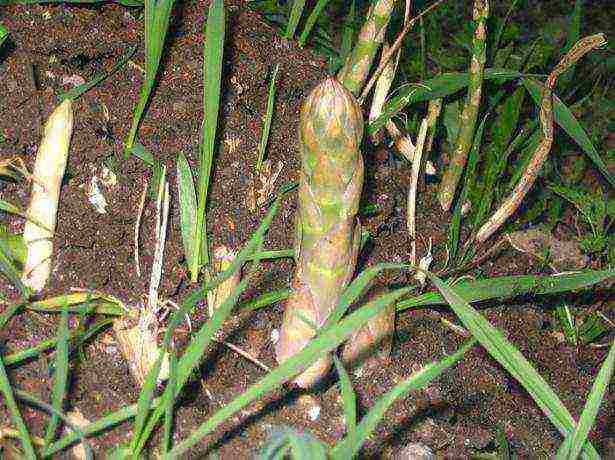
Within a month, water the asparagus, gently loosen the soil and turn the seedlings in different directions to the light for even growth.
In the last days of May, the seedlings must be hardened: every day, subject to good weather, put containers with plants outside. Hardening begins at one hour and gradually increases to 12 hours. By the beginning of June, the seedlings will be fully ready for transplanting to their permanent place in the garden.
For young plants, a bed of 100 cm in width, 30 cm in height will be sufficient.A distance of 40 cm should be left between the seedlings, and up to 60 cm between the rows.
How does asparagus grow from rhizomes?
More popular is the propagation of asparagus using segments of rhizomes with live buds. The survival rate of plants in this case is almost 100%. Planting with rhizomes is carried out both in spring and before winter. Let's take a closer look at the technology of planting asparagus in May.
Having chosen the strongest, fleshy rhizomes on the market, divide them into several parts. Carefully place each part in a previously dug hole 50 cm deep, on the bottom of which a mound of earth mixed with humus is poured. Thus, the seedling should be deepened by 25 cm.The optimal distance between the bushes is 15 cm, the intervals between the rows are 50 cm.

Having chosen the strongest, fleshy rhizomes on the market, divide them into several parts
When planting, try to spread the root system well, cover the rhizomes on top with a mixture of soil with humus and press down firmly. Then pour a little water over the garden bed.
Further cultivation and care of asparagus
Regardless of whether asparagus is planted with rhizomes or seeds, the subsequent care for it will be the same. Immediately after planting on the plant site, you will need to water abundantly for the first one and a half to two weeks, then sprinkle the holes with peat and reduce watering.
During the summer, it is necessary to regularly remove weeds, loosen the soil in the aisles and water it from time to time so that the earth does not dry out, but it is also impossible to overmoisten it. To speed up the growth of shoots, after the first weeding, you can add fertilizing to the garden bed from water-diluted slurry (6 parts of water per 1 part of slurry). After three weeks, it is recommended to feed the plants with bird droppings diluted 10 times with water. And already before the first frosts, the last feeding is carried out with a complex mineral fertilizer.

During the summer, it is necessary to regularly remove weeds, loosen the soil in the aisles and water from time to time
For the winter, the upper part of the asparagus is cut off, leaving only "stumps" of 2.5 cm, which are covered with earth, covered with humus and dry leaves on top. The aisles are covered with manure.
Caring for asparagus in the second year looks exactly the same as in the first. And as much as you would like to try juicy shoots, be patient until next year so that they are filled with strength and accumulate more vitamins. Cutting the stems prematurely will nullify all your efforts.
In Europe, it is customary to cut off asparagus shoots only when the height is at least 22 cm, and the diameter is at least 1.6 cm.
In the third year, with the arrival of spring, the planting will need to be hilled so that the asparagus grows long, straight, and its heads do not open ahead of time. From about the end of April, the time for the first harvest begins. Try not to miss the moment when the heads have not yet had time to appear above the surface, otherwise the shoots will lose their presentation, change color and become deeper.
Video about growing asparagus on your site
You can determine readiness by cracking the ground above each plant. As soon as you notice that the soil has risen and cracks have appeared, then it's time to dig up the stems, cutting them to the very root. In warm weather, you can pick asparagus every day or every other day. Just do not remove all the shoots at once, otherwise the plant may die.
After cutting the crop, level the garden bed, sprinkle it with humus on top and compact it slightly. In the future, caring for the asparagus is repeated, as in the first two years.
Rate the article:
(2 votes, average: 3 out of 5)
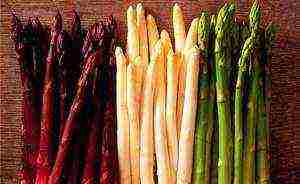 The genus of plants Asparagus or Asparagus belongs to the asparagus family and has more than 300 species. In the wild, Asparagus can be found in the European part of Russia and the Caucasus, most often in arid regions. The plant is cultivated in Western Europe, Japan, India, USA, China. There was a time when asparagus belonged to the lily family, but now it has its own asparagus family.
The genus of plants Asparagus or Asparagus belongs to the asparagus family and has more than 300 species. In the wild, Asparagus can be found in the European part of Russia and the Caucasus, most often in arid regions. The plant is cultivated in Western Europe, Japan, India, USA, China. There was a time when asparagus belonged to the lily family, but now it has its own asparagus family.
Asparagus is a perennial plant. Outwardly, it is branched grasses and shrubs, and sometimes lianas. Asparagus has a very developed root system.
Description
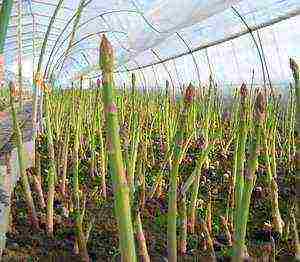 Asparagus has highly branched stems that can grow to one and a half meters high. Most plants lack green leaves, and those that do have them tend to grow underdeveloped and very small.
Asparagus has highly branched stems that can grow to one and a half meters high. Most plants lack green leaves, and those that do have them tend to grow underdeveloped and very small.
At their base, the leaves form hard spurs. There are very small flowers, which are usually concentrated in the axils of the leaves. Flowers grow in thyroid or racemose inflorescences.
Asparagus flowers can be either unisexual or bisexual. The flowers have six petals arranged in two rows.
 In indoor conditions, it is most often found Common asparagus... In vegetable gardens, they are also planted in the form of a vegetable, and are also often used in drawing up bouquets of flowers. This species was discovered over 2000 years ago.
In indoor conditions, it is most often found Common asparagus... In vegetable gardens, they are also planted in the form of a vegetable, and are also often used in drawing up bouquets of flowers. This species was discovered over 2000 years ago.
In the days of Ancient Egypt, asparagus was grown as a vegetable, used for medicinal purposes, or just as an ornamental plant. The roots of Asparagus vulgaris are very rich in nutrientsincluding vitamin C.
Now let's take a closer look at how to grow Asparagus at home and outdoors.
Growing asparagus: how to grow asparagus from seeds, planting and care
 The easiest way to plant Asparagus is planting seeds... These seeds can be purchased at any specialty store. Asparagus seeds are large enough, and sowing them will not cause any difficulties.
The easiest way to plant Asparagus is planting seeds... These seeds can be purchased at any specialty store. Asparagus seeds are large enough, and sowing them will not cause any difficulties.
Asparagus is planted in early spring. The seeds are sown in light moist soil. The substrate should consist of equal parts of fertile soil and sand. The seeds are sprinkled with a thin layer of soil. Then the container is covered from above with glass or transparent film. The container with the seeded Asparagus is removed to a room with room temperature and sufficient light. If excess condensation appears on the glass, then the glass must be removed for a short time. The first shoots of Asparagus will be visible in a month.
Location and lighting at home
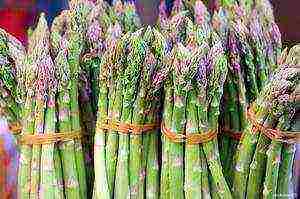 Asparagus - very light-loving plant, so he prefers a fairly lit place. However, it is worth avoiding direct sunlight on the plant. In particular, this applies to the summer period, when the day is especially long.
Asparagus - very light-loving plant, so he prefers a fairly lit place. However, it is worth avoiding direct sunlight on the plant. In particular, this applies to the summer period, when the day is especially long.
A pot of Asparagus will do well on the east and west side. If the plant is placed on the south side, then it necessary shade and create diffused lighting to avoid direct sunlight. In summer, Asparagus can be taken out into the open air, also placed in partial shade.
Pot size
 Pot size for Asparagus directly depends on the type of plant. If the plant was purchased in a store, then it is better to immediately transplant it into a new pot. But in order for it to differ in size not much from the previous one, therefore, you should not select a pot for Asparagus with a margin.
Pot size for Asparagus directly depends on the type of plant. If the plant was purchased in a store, then it is better to immediately transplant it into a new pot. But in order for it to differ in size not much from the previous one, therefore, you should not select a pot for Asparagus with a margin.
Otherwise, it can lead to acidification of the soil and death of the plant. The shape of the pot is also irrelevant. This most often depends on where the Asparagus will be located or on decorative preferences. Some types of Asparagus look very attractive in:
- hanging pots;
- miniature pots on windowsills;
- large pots standing on the floor.
Growing soil
 Asparagus is very unpretentious in terms of soil. Part of the land can be taken from a vegetable garden or garden, add a part of deciduous soil, which can be taken in a forest or park. A little coarse sand can be added to the mixture, which will give the substrate fragmentation.
Asparagus is very unpretentious in terms of soil. Part of the land can be taken from a vegetable garden or garden, add a part of deciduous soil, which can be taken in a forest or park. A little coarse sand can be added to the mixture, which will give the substrate fragmentation.
This soil mix provides Asparagus with all necessary nutrients, and promotes moisture and air to circulate freely. It will be very nice if you put a thin layer of pieces on the bottom of the pot. charcoal... This will prevent the process of rotting in the soil and the development of fungal diseases. Thus, adherence to the composition of the soil will significantly affect the health of the plant.
Transplant and care after it
 Before proceeding with the transplant, necessary prepare a new pot and soil in advance. Then the Asparagus is carefully removed from the container without damaging the root system. You can knock on the sides of the pot, turn it over and carefully remove the earthen lump.
Before proceeding with the transplant, necessary prepare a new pot and soil in advance. Then the Asparagus is carefully removed from the container without damaging the root system. You can knock on the sides of the pot, turn it over and carefully remove the earthen lump.
If, after such a procedure, the plant is still difficult to remove, then it is necessary to water the soil so that it becomes very wet. At the bottom of the new pot, a small stone or expanded clay is poured as drainage, which will allow the water to drain freely in the water and not stagnate in the pot.
Next, a layer of substrate is poured into the pot. At Asparagus carefully the root system is examined, I remove the damaged roots. Old soil is shaken off from the roots. The plant is then placed in a new pot, gently spreading out the root system. Soil is gradually poured from above. You cannot accept the soil, but you should not leave air voids. The final stage of the transplant will be watering Asparagus warm infused water. After transplanting, the plant must be placed in a shaded place for a couple of days.
Fertilizers and top dressing are the key to successful cultivation
 Care and cultivation of asparagus also requires regular feeding... During the intensive growth of Asparagus during irrigation in water, it is necessary to add concentrated fertilizers. The frequency with which it is worth feeding the plant depends on the time of year and the state of Asparagus itself.
Care and cultivation of asparagus also requires regular feeding... During the intensive growth of Asparagus during irrigation in water, it is necessary to add concentrated fertilizers. The frequency with which it is worth feeding the plant depends on the time of year and the state of Asparagus itself.
Plants usually start feed in early spring, and finish feeding in late autumn. In winter, when the dormant period for Asparagus comes, it is not recommended to feed the plant, and the watering itself should be reduced. In the summer, when Asparagus is outside, it can be fed with organic fertilizers. Chicken droppings work well.
 It is also worth remembering that you should not feed Asparagus for the first two months after transplantation. During feeding it is necessary strictly observe the concentration, following the instructions on the package, otherwise you can burn the root system of the plant.
It is also worth remembering that you should not feed Asparagus for the first two months after transplantation. During feeding it is necessary strictly observe the concentration, following the instructions on the package, otherwise you can burn the root system of the plant.
The main pest of Asparaguslike most houseplants, the spider mite is. If you do not start fighting the parasite in time, then it can destroy the plant. This pest multiplies quite quickly. To do this, he needs a high temperature. The spider mite feeds on the sap of the plant. It mostly hides on the back of the leaves.
 The first sign of presence spider mite will change the color of the leaves of Asparagus. They will turn yellow and dry out a little. A small cobweb can be seen between the leaves. Small white cotton spots also appear on the leaves of the plant.
The first sign of presence spider mite will change the color of the leaves of Asparagus. They will turn yellow and dry out a little. A small cobweb can be seen between the leaves. Small white cotton spots also appear on the leaves of the plant.
When attacked by a pest, the leaves of Asparagus must be wiped soapy water... If this method no longer helps, then you can turn to insecticides for help. But it is worth remembering that Asparagus does not tolerate chemical treatment well, therefore it is best to avoid contamination of the plant with a spider mite, observing the conditions of the temperature regime.
Growing asparagus outdoors
But what about planting and growing Asparagus outdoors?
 When to plant outdoors? Planting asparagus outdoors should be done in early June. In the open field, the plant will feel great in well-lit and calm places, it is advisable to plant it near walls or a fence.
When to plant outdoors? Planting asparagus outdoors should be done in early June. In the open field, the plant will feel great in well-lit and calm places, it is advisable to plant it near walls or a fence.- Since asparagus does not like waterlogging of the soil, it should not be planted in places where groundwater is high. The choice of a place for planting asparagus in open ground must be approached as responsibly as possible, since this culture can grow in one place for up to 25 years.
- How to choose a soil? The optimal soil for asparagus is a mixture of rich and fertile sandy loam soil. The area for planting asparagus in the open field must be started from the fall. First of all, the site must be cleared of weeds and dug to a depth of 50 cm with the introduction of compost, superphosphate and potassium sulfate. In the spring, when the snow melts, this area must be harrowed with the simultaneous introduction of ammonium nitrate and wood ash per square meter.
 How to plant asparagus outdoors? Before planting asparagus in the open ground in the prepared area, it is necessary to make holes on it with a depth of 30 cm and a width of 40 cm. The holes should be at a distance of 1 m from each other. The soil in the groove is loosened to a depth of 20 cm.
How to plant asparagus outdoors? Before planting asparagus in the open ground in the prepared area, it is necessary to make holes on it with a depth of 30 cm and a width of 40 cm. The holes should be at a distance of 1 m from each other. The soil in the groove is loosened to a depth of 20 cm.- After that, a pile of loose soil can be poured onto the bottom of the hole so high that it reaches the edges of the hole. An asparagus seedling is planted on the resulting mound, but it is necessary to first shorten its root to 3 cm, then fill the hole with soil, compact it well, then water it. When the water is absorbed into the soil, the hole must be mulched with dry soil.
Bloom
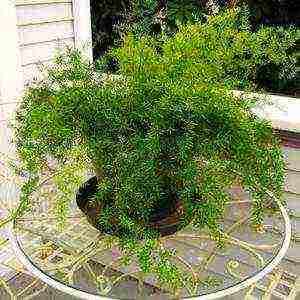 Whatever the care and maintenance, at home it is very hard achieve flowering of Asparagus, even if all the necessary conditions are met. But if it is possible to achieve the flowering of the plant, then the flowers look rather inconspicuous.
Whatever the care and maintenance, at home it is very hard achieve flowering of Asparagus, even if all the necessary conditions are met. But if it is possible to achieve the flowering of the plant, then the flowers look rather inconspicuous.
Outwardly, these are very small white flowersthat are formed on the upper segment of the shoots. After some time, after artificial pollination, the flowers are formed into small red fruits, with a scent reminiscent of an orange. It is worth avoiding getting these berries into the hands of young children, because the fruits of Asparagus are poisonous.
Reproduction
There are three main ways to breed asparagus:
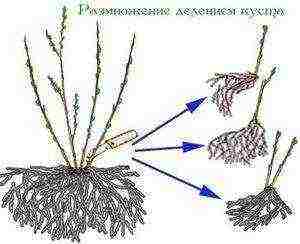 Division of the bush. This method is best used in the spring when transplanting the plant. Depending on the size of the Asparagus, it can be divided into several parts, each of which must be planted in a separate pot. Dividing the bush is less traumatic for the entire plant as a whole.
Division of the bush. This method is best used in the spring when transplanting the plant. Depending on the size of the Asparagus, it can be divided into several parts, each of which must be planted in a separate pot. Dividing the bush is less traumatic for the entire plant as a whole.- Cuttings. Propagation by cuttings must be done in early spring. The cuttings must be at least 10 cm long. River sand is used to root the shoot. The container in which the cutting is planted must be covered with plastic wrap in order to retain as much moisture as possible. Then the plant is placed in a room with a temperature of at least 20 degrees. With this method, asparagus takes root in a month, after which it is transplanted into a separate pot.
- Asparagus fruits produce seeds. Seed collection must be done between January and March. Sowing seeds is necessary immediately after harvesting. The seeds are sown into the soil from peat and river sand. The container with the sown seeds is covered with a transparent film and placed in a room with a temperature of at least 22 degrees. A month later, new seedlings appear, which must be transplanted into a separate pot in June.
Dormant period
The dormant period for Asparagus is from November to early March. At this time, the plant must be provided with sufficient air humidity, as well as reduce watering. Feed the plant during the dormant period no need.
Plant toxicity / beneficial properties
Asparagus berries are poisonous, so the plant should be placed further or higher so that its fruits are not available to small children.
> > > > >
